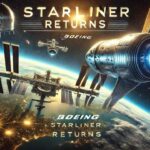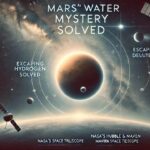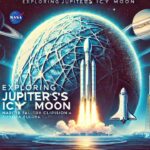NASA Starliner, astronaut return, Sunita Williams, Butch Wilmore, Starliner spacecraft, Boeing NASA partnership, ISS mission delay, space mission challenges, NASA space news, human spaceflight
Explore the challenges faced by NASA in safely returning astronauts Sunita Williams and Butch Wilmore from orbit due to ongoing technical issues with Boeing’s Starliner spacecraft. This article delves into the mission’s complications, NASA’s cautious approach, and the broader implications for the future of human spaceflight.

NASA’s Starliner Mission: The Challenge of Returning Astronauts from Orbit
NASA’s human spaceflight programs have long been synonymous with exploration, innovation, and, unfortunately, challenges. The recent technical issues with Boeing’s Starliner spacecraft have highlighted the complexities and risks involved in space missions. Astronauts Sunita Williams and Butch Wilmore, who were expected to be in space for only a few days, have now been in orbit for more than two months. The delays in their return are due to ongoing technical problems with the Starliner spacecraft, raising concerns about when and how these astronauts will safely return to Earth.
The Initial Mission and Unforeseen Complications
The Starliner mission, which was launched on June 5, 2024, was originally planned as a short-duration test flight aimed at validating the spacecraft’s systems and performance. However, the mission encountered significant challenges during its first docking attempt on June 6, when the spacecraft’s reaction control thrusters failed, preventing it from docking with the International Space Station (ISS). This unexpected failure extended the mission far beyond its intended timeframe, with Williams and Wilmore now having spent nearly 70 days in space.
NASA has been working diligently with Boeing to resolve the issues with Starliner’s propulsion system. Ground engineers have been evaluating the glitches, but as of the latest updates, the space agency has yet to finalize a solution. This has led to uncertainty about when the astronauts will return to Earth, with potential scenarios including their return on the Starliner or a delay until February 2025 when they could be brought back aboard a SpaceX Dragon capsule.
The Pressure of Decision-Making
NASA is facing mounting pressure to make a decision on the astronauts’ return. Ken Bowersox, NASA’s Associate Administrator for Space Operations, emphasized the urgency of the situation, stating that a decision needs to be made by the last week of August. The astronauts, while making the best of their extended stay aboard the ISS, are undoubtedly eager for clarity on their return timeline.
The space station environment, while fascinating and rewarding, presents its own set of challenges, including isolation, limited communication with loved ones, and the physical effects of prolonged weightlessness. The psychological and physical well-being of astronauts on long-duration missions is a priority for NASA, and the uncertainty surrounding their return adds to the complexity of managing their mission.
The Technical and Logistical Challenges
The Starliner’s propulsion system issues are at the heart of the delay. The reaction control thrusters are critical for the spacecraft’s maneuverability, especially during docking and undocking procedures. A failure in this system poses significant risks during re-entry into Earth’s atmosphere, where precise control is essential for a safe landing.
NASA has indicated that the Starliner remains rated as an escape vehicle, meaning it is still considered safe for the crew to return in an emergency. However, the space agency’s caution is understandable, especially considering the tragic losses of 14 astronauts in the Challenger and Columbia space shuttle disasters in 1986 and 2003, respectively. NASA’s rigorous safety protocols and commitment to astronaut safety mean that any potential risks are thoroughly evaluated before a final decision is made.
The Role of Boeing and the Future of Starliner
Boeing, as the manufacturer of the Starliner, has faced significant scrutiny over the spacecraft’s performance. The company has been under pressure to deliver a reliable spacecraft after years of delays and cost overruns. The Starliner program, which is part of NASA’s Commercial Crew Program, was intended to provide an alternative to SpaceX’s Dragon capsule for transporting astronauts to and from the ISS. However, the ongoing issues with Starliner have cast doubt on its reliability and viability as a regular crew transport vehicle.
Boeing engineers are reportedly confident that the Starliner is safe to bring the crew home, but NASA’s caution reflects the need for thorough testing and validation of the spacecraft’s systems. The absence of a Boeing representative at recent NASA briefings has fueled speculation about tensions between the space agency and its commercial partner. Despite this, both organizations have emphasized their commitment to working together to resolve the issues and ensure the safe return of the astronauts.
The Implications for NASA’s Commercial Crew Program
The delays and technical challenges faced by the Starliner mission have broader implications for NASA’s Commercial Crew Program. The program was designed to foster competition and innovation in the development of crewed spacecraft, with the goal of providing reliable and cost-effective transportation to low Earth orbit. SpaceX’s Dragon capsule has already demonstrated its capabilities with multiple successful missions, while Boeing’s Starliner was expected to provide a second option.
The setbacks with Starliner highlight the difficulties of developing new spacecraft and the importance of redundancy in space transportation. While SpaceX’s Dragon capsule remains a reliable option, the issues with Starliner underscore the need for continued investment in technology development and risk mitigation.
The Future of Human Spaceflight
The Starliner mission serves as a reminder of the challenges and uncertainties inherent in human spaceflight. While space exploration offers incredible opportunities for discovery and innovation, it also comes with significant risks. NASA’s cautious approach to the Starliner mission reflects the agency’s commitment to safety and its determination to avoid past mistakes.
As NASA and Boeing work to resolve the issues with Starliner, the focus remains on ensuring the safe return of Sunita Williams and Butch Wilmore. The decision on whether to bring them home on Starliner or delay their return until 2025 will depend on the outcome of ongoing evaluations and testing.
The challenges faced by the Starliner mission also highlight the importance of collaboration between NASA and its commercial partners. The success of future human spaceflight missions will depend on the ability of these organizations to work together, overcome technical challenges, and prioritize the safety and well-being of astronauts.
Conclusion
The ongoing issues with Boeing’s Starliner spacecraft have put NASA in a difficult position as it seeks to safely return astronauts Sunita Williams and Butch Wilmore to Earth. The delays and technical challenges faced by the mission underscore the complexities of space exploration and the importance of rigorous safety protocols. As NASA works to resolve the issues with Starliner, the focus remains on ensuring the safe return of the astronauts and the future success of the Commercial Crew Program.
The outcome of this mission will have significant implications for the future of human spaceflight, as NASA continues to explore new frontiers and push the boundaries of what is possible. The lessons learned from the Starliner mission will undoubtedly inform future space missions and help to ensure the safety and success of astronauts in space.
In the end, the resilience of NASA, Boeing, and the astronauts themselves will be key to overcoming the challenges faced by the Starliner mission and paving the way for future successes in human spaceflight.
Read More
- Why NASA Scientists Believe We Might Not Detect Solar Panel Technosignatures from Alien Civilizations
- NASA Announces SpaceX Crew 10 Assignments for 2025 Space Station Mission
- NASA CURIE Mission: Exploring the Origins of Solar Radio Waves
- Top 5 BEST Humidifiers of 2023










